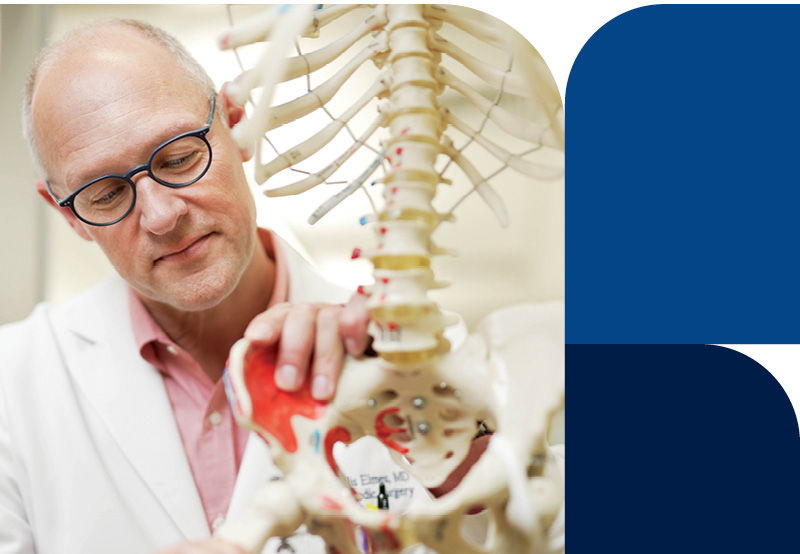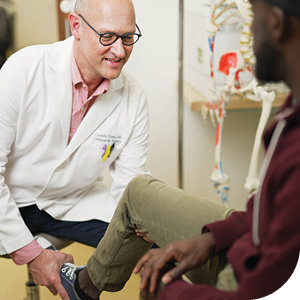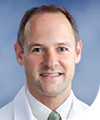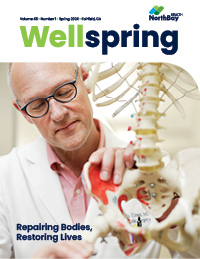
Ready to Repair, When Bones Break
Most people think trauma cases involve car crashes and dramatic falls, but for some older Solano County residents, simply twisting the wrong way can result in a hip fracture.
That’s because osteoporosis decreases mass and density, making bones brittle and vulnerable. It can affect men and women of all races, but white and Asian women, especially older women past menopause, are at the highest risk. And with Solano County’s growing population of aging Baby Boomers, cases like these are becoming more frequent.
In fact, a ground level fall has become the No. 1 trauma injury to roll through the doors of NorthBay Health Medical Center’s Emergency Department. A stumble off a door step or curb, over the family dog, or off of a ladder can both debilitating and devastating.
“We rarely need to transfer patients from NorthBay Health to a higher level of care because our team can perform all those types of complex procedures right here. We can perform state-of-the-art hip replacement surgeries caused by fractures, as well.”
Jay Parkin, M.D., Orthopedic Surgeon and Director, Orthopedic Trauma Program
The good news is that NorthBay Health has two experienced, trauma-trained orthopedists ready to repair broken bones and get patients on the mend: Cornelis Elmes, M.D., and Jay Parkin, M.D., director of the Orthopedic Trauma Program at NorthBay Health Medical Center. In addition, several other surgeons are Fellowship-trained in trauma.
“We rarely need to transfer patients from NorthBay Health to a higher level of care because our team can perform all those types of complex procedures right here,” said Dr. Parkin “We can perform state-of-the art hip replacement surgeries caused by fractures, as well.”
Dr. Elmes has cultivated a reputation for repairing the most severely damaged hip bones and pelvises after years working in Level I and II trauma centers in New York, Florida and California. In recent years, he’s seen the number of osteoporosis trauma cases skyrocket.
“Every day I’m seeing them in the operating room,” Dr. Elmes noted. “It has become an epidemic.”
The cases are particularly challenging, but that’s right in Dr. Elmes’ surgical wheelhouse.

“These bones are of poor quality and if the break is very bad, there may be a lot of bone pieces that need to be put back together. You can imagine how much more difficult that job would be if all those bone pieces were fragile and brittle. So, my challenge is to fix the break well enough that it can heal without everything falling apart.”
Dr. Elmes says if a patient suffers a hip fracture from a ground level fall, he knows immediately that it’s due to osteoporosis.
“It shouldn’t be that easy to fracture a hip, because it usually takes a lot of energy to break that bone. In a younger person, it would require a car crash or from falling out of a window for a hip to break.”
So, which is worse, a pelvic fracture, or a hip fracture? Some might think it’s the pelvis, as it cradles the spine, hips and many internal organs. But, in Dr. Elmes’ opinion, it’s actually a hip fracture for older adults.
“Unlike pelvic fractures in younger patients, pelvis fractures in older patients are usually more stable and can often heal without surgery,” he said. “Patients will use crutches, walker, cane or a wheelchair while they recuperate.”
That is not usually the case for hip fractures.
“Hip fractures almost always require surgery to heal quickly and correctly. The fracture can be very painful and it’s important to fix the hip as soon as possible,” he said. “With hip fractures, days matter. The sooner you get the patient to the operating room, the greater the chance that person will be able to return to his or her previous level of independence and function.”
Concerned about your bone health? Make an appointment with your primary care physician to discuss family history and risks, and to be tested for Vitamin D deficiency, Dr. Elmes advised.
“Anyone over age 40 should make sure their diet has enough calcium and Vitamin D. That way you’ll see your primary care physician and not an orthopedic surgeon!” he added.


